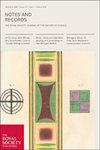The collecting activities of James Cuninghame FRS on the voyage of Tuscan to China (Amoy) between 1697 and 1699
IF 0.6
3区 哲学
Q3 HISTORY & PHILOSOPHY OF SCIENCE
Notes and Records-The Royal Society Journal of the History of Science
Pub Date : 2015-06-20
DOI:10.1098/RSNR.2014.0043
引用次数: 8
Abstract
James Cuninghame's visit to China (1697–99) yielded a great deal of valuable information on both natural and artificial objects as well as items of contemporaneous trade interest (for example china clay and a scarlet dye). However, the circumstances surrounding the voyage have long been unclear. Although it has previously been assumed that Cuninghame must have travelled on an East India Company vessel, it now seems that he was aboard Tuscan, one of two private trading ships (interlopers) bound for Amoy under the command of Henry Gough. After an incident in La Palma (Canary Islands), only Tuscan proceeded to China after her release by the Spanish authorities. Study of surviving correspondence between Cuninghame and a Canarian cleric, Juan Bautista Poggio, has contributed to a better understanding of the events in the early part of the voyage. Cuninghame made extensive natural history collections during the six months that Tuscan remained in Amoy, before returning to England in 1699, where his specimens delighted his London supporters, James Petiver and Hans Sloane.1697年至1699年,詹姆斯·康宁汉在托斯卡纳到中国(厦门)航行中的收集活动
詹姆斯·康宁汉的中国之行(1697-99年)收获了大量关于自然和人造物品以及当时贸易兴趣的物品(例如瓷器粘土和一种猩红染料)的宝贵信息。然而,这次航行的具体情况长期以来一直不清楚。虽然之前有人认为,库宁海姆一定是乘坐东印度公司的船只旅行的,但现在看来,他乘坐的是托斯卡纳号,这是亨利·高夫指挥下开往厦门的两艘私人商船(闯入者)中的一艘。在拉帕尔马(加那利群岛)发生事件后,只有托斯卡纳在被西班牙当局释放后前往中国。对康宁哈姆和加那利牧师胡安·包蒂斯塔·波乔(Juan Bautista Poggio)之间现存通信的研究,有助于更好地理解航行早期发生的事件。在托斯卡纳留在Amoy的六个月里,库宁汉收集了大量的自然历史标本,直到1699年回到英国,他的标本让他在伦敦的支持者詹姆斯·珀蒂弗和汉斯·斯隆感到高兴。
本文章由计算机程序翻译,如有差异,请以英文原文为准。
求助全文
约1分钟内获得全文
求助全文
来源期刊
CiteScore
1.50
自引率
0.00%
发文量
45
审稿时长
>12 weeks
期刊介绍:
Notes and Records is an international journal which publishes original research in the history of science, technology and medicine.
In addition to publishing peer-reviewed research articles in all areas of the history of science, technology and medicine, Notes and Records welcomes other forms of contribution including: research notes elucidating recent archival discoveries (in the collections of the Royal Society and elsewhere); news of research projects and online and other resources of interest to historians; essay reviews, on material relating primarily to the history of the Royal Society; and recollections or autobiographical accounts written by Fellows and others recording important moments in science from the recent past.

 求助内容:
求助内容: 应助结果提醒方式:
应助结果提醒方式:


